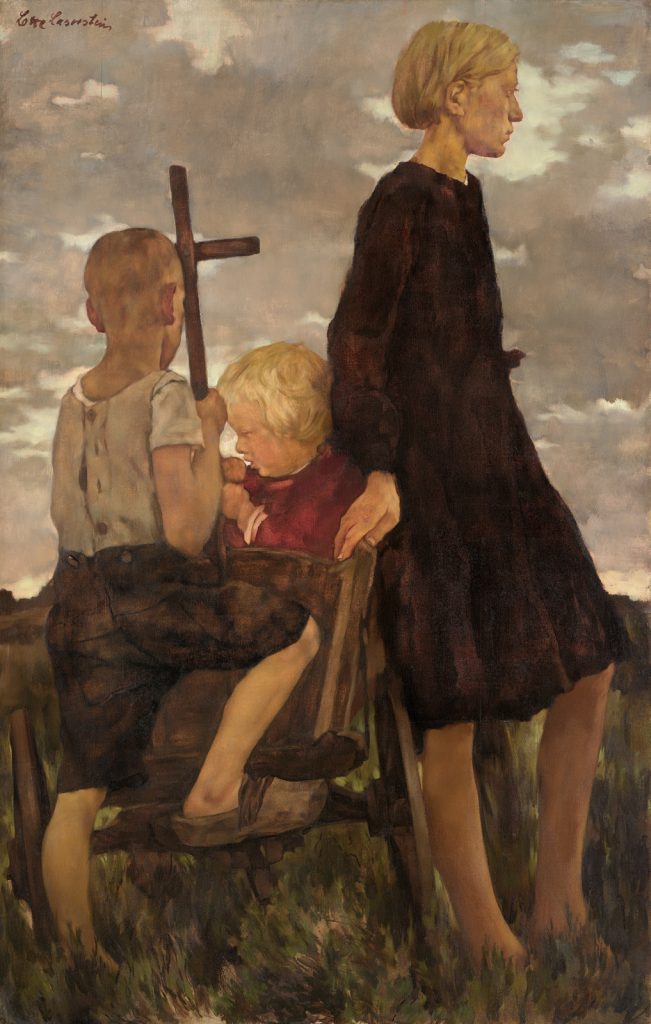Lotte Laserstein
(Preussisch Holland, East Prussia 1898 - 1993 Kalmar, Sweden)
Children with a Handcart, 1932
Oil on panel, 126 x 81 cm
Signed upper left Lotte Laserstein
Provenance:
With the artist, Berlin (1932);
held with the artist in Sweden from 1937;
private collection, Sweden, acquired directly from the artist;
thence by descent, Sweden.
Literature:
Anna-Carola Krausse, Lotte Laserstein (1898-1993). Leben und Werk, Berlin 2006, no. M 1932/14
Lotte Lasterstein executed this painting on a study trip to northern Germany in 1932. She was based at Neu Sankt Jürgen, a small village in the Teufelsmoor region near the artists’ colony of Worpswede. Laserstein thought very highly of the work of one of the most famous figures associated with Worpswede, namely Paula Modersohn-Becker (1876-1907). The study trip is documented in photographs found among the artist’s papers after her death. Laserstein was active as a private teacher in Berlin. In the years 1931 to 1935 she took her painting classes on a number of excursions into the countryside, particularly the Lüneburger Heide, and to the coastal town of Sahlenburg near Cuxhaven. In 1932 the class visited the Teufelsmoor region. Her usual practice was to set the class a theme and then work on it with them, rounding up the session with a discussion of the finished results (see Fig. 1).
She was entirely conversant with the ‘rich iconographic fundus of art history’1and confidently handled references to it. Her debt to the Old Masters was considerable and evidence of her engagement with old master traditions runs through her entire oeuvre. She frequently focused on Pathosformeln2 – visual representations of pity and intense sadness often found in religious paintings. She would then secularize familiar religious symbols. One notable example is found in the painting Evening over Potsdam, one of her major works. In the painting’s allusion to the Last Supper Laserstein references a motif from Christian iconography. The present painting is a further example. Here, the shaft of the handcart resembles a crucifix. While depriving religious motifs of their sacred character she would highlight elements of pity and sadness.
Anna-Carola Krausse, the author of the Lotte Laserstein catalogue raisonné, comments on the present work:
The painting Children with a Handcart can be ranked as one of the most important pieces to have been produced by Lotte Laserstein in the 1930s. It was painted two years later than her major work Evening over Potsdam (Fig. 2) and is infused with the same contemplative absorption that characterizes the group seated at the Potsdam table. A small boy and a young girl are depicted standing beside a handcart. Sitting between them in the cart is a small, fair-haired child. The figures seem pensive, cramped together in a confined space, and oblivious to one another. The rich velvety red of the child’s pullover provides a bright accent against the otherwise muted tones of the palette. The raised, clenched fists of the infant strike a contrast with the statuesque immobility of the figures as they stare out over the flat expanse of brown moor with an air of passive resignation. Set against the cloudy sky, the farm children seem monumentalized by the low vantage point but are innately unheroic. Heavy clouds obscure the light and emphasize the somber quality of the scene. Its atmosphere is an additional factor that recalls the Potsdam work. There too, a darkening sky plays a major role in the composition. Similarly, in the present painting Laserstein also incorporates an allusion to a religious motif – her depiction of the shaft of the handcart held up by the boy immediately recalls a crucifix.

Fig. 2 Lotte Laserstein, Evening over Potsdam, 1930, oil on panel, 110 x 205.5 cm. © Nationalgalerie, Staatliche Museen zu Berlin.
The present painting is a fine example of Laserstein’s ‘melancholy realism’. Her technical virtuosity and the remarkable empathy she depicts in her portrayal of her models are revealed in the delicacy of her execution and her confident compositional approach. The broad handling also allows for meticulous attention to detail, for example in the treatment of facial features, the hands of the girl, and the shirt and neck of the boy. In a subtle way, the fate of the children from the ‘cheerless countryside’ – as Lasterstein liked to describe the Teufelsmoor – seems in equal measure indeterminate and predetermined.
Children with a Handcart is ranked among Lasersteins’s best works of the 1930s. She herself evidently valued the finished painting very highly because she had it professionally photographed – probably in her Berlin studio. The photograph of the work is now held in the archives of the Universität der Künste in Berlin. When the catalogue raisonné of Laserstein’s oeuvre went to press in 2006 the photograph was the only record of the painting’s existence and its whereabouts were unknown. It was only recently discovered in a Swedish private collection. It is one of a number of paintings she was able to save and take with her when she went into exile in 1937. She sold the works at a later date in Sweden. The former owner of the present painting has stated that it was acquired directly from Laserstein.
1 Anna-Carola Krausse, Lotte Laserstein: Meine einzige Wirklichkeit, Berlin 2018, p. 57.
2 The concept of the Pathosformel (‘pathos formula’) was developed by the art historian Aby Warburg (1866-1929) in the early twentieth century.


